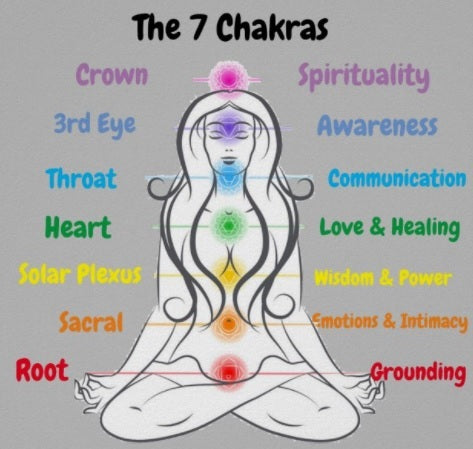In the fascinating realm of spirituality, the concept of chakra leaves many curious minds intrigued. It is a term that is often mentioned, but have you ever wondered what it truly means? Chakra, derived from the ancient Sanskrit language, holds a deeper meaning that extends beyond its physical association with energy centers in the human body. Embark on a spiritual journey as you uncover the essence and significance of chakra in this enlightening article.
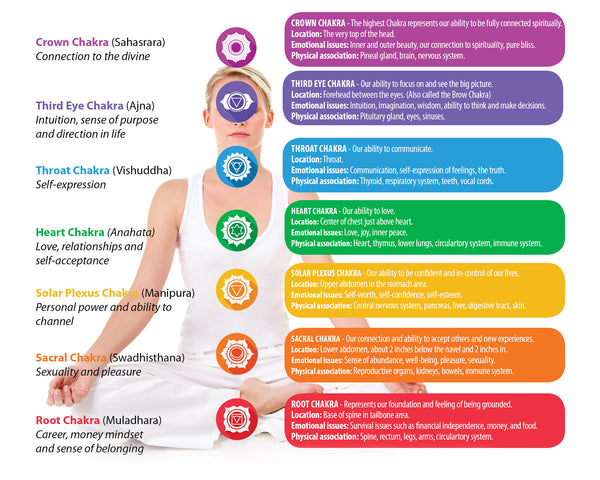
Chakra Overview
Definition of chakra
A chakra, in the spiritual context, refers to the energy centers within the human body that are believed to be responsible for the flow of life force energy. The word “chakra” originates from Sanskrit and translates to “wheel” or “disk,” symbolizing the spinning nature of these energy centers.
Origin of the concept
The concept of chakras can be traced back to ancient Indian scriptures and texts, particularly the Vedas and Upanishads. These ancient texts describe the chakras as vital points where energy channels intersect. The earliest reference to chakras can be found in the Brihadaranyaka Upanishad, dating back to approximately 700 BCE.
Purpose and importance of chakras in spirituality
Chakras play a crucial role in spirituality as they are believed to be the portals that connect the physical and spiritual aspects of an individual. They are seen as the gateways to higher consciousness and self-realization. By accessing and working with the chakras, individuals can enhance their spiritual growth, promote emotional and physical well-being, and achieve a deeper understanding of themselves and the universe.
Seven Main Chakras
Root chakra (Muladhara)
The root chakra is the foundation of the chakra system, located at the base of the spine. It represents stability, grounding, and our connection to the physical world. When balanced, it fosters feelings of security, strength, and vitality.
Sacral chakra (Svadhisthana)
The sacral chakra is situated in the lower abdomen, just below the navel. It is associated with creativity, passion, and sensuality. A balanced sacral chakra enables the free flow of emotions and encourages joy, pleasure, and a harmonious relationship with oneself and others.
Solar Plexus chakra (Manipura)
Located in the upper abdomen, the solar plexus chakra is associated with personal power, confidence, and self-esteem. A balanced solar plexus chakra empowers individuals to trust their inner wisdom, take assertive actions, and maintain a balanced sense of self.
Heart chakra (Anahata)
The heart chakra, situated in the center of the chest, represents love, compassion, and emotional healing. It serves as the bridge between the lower and higher chakras, fostering feelings of empathy, forgiveness, and unconditional love towards oneself and others.
Throat chakra (Vishuddha)
The throat chakra, located at the throat region, governs communication, self-expression, and authenticity. When balanced, it allows individuals to speak their truth, express themselves creatively, and listen attentively.
Third Eye chakra (Ajna)
Positioned between the eyebrows, the third eye chakra is associated with intuition, insight, and spiritual awareness. It enhances inner vision, imagination, and the ability to perceive beyond the physical realms.
Crown chakra (Sahasrara)
Situated at the crown of the head, the crown chakra represents the individual’s connection to their higher self and the divine. It encompasses pure consciousness, spiritual enlightenment, and a sense of oneness with the universe.
Understanding Chakra Energy
Chakra as energy centers
Chakras are considered as spinning vortexes of energy within the subtle body. Each chakra holds and distributes life force energy, also known as prana or chi, throughout the physical, emotional, mental, and spiritual aspects of an individual. They serve as conduits, regulating the energy flow and maintaining overall well-being.
Balancing and aligning chakras
Balancing and aligning the chakras is crucial for optimal functioning and vitality. Various practices, such as meditation, energy healing, yoga, and breathwork, can be employed to facilitate the harmonization of the chakras. These practices aim to remove blockages, restore the flow of energy, and promote balance within the entire chakra system.
Flow of energy through chakras
The energy within the chakras is not static but flows continuously. It moves from the lower chakras, associated with more physical and earthly aspects, to the higher chakras, which are connected to the more spiritual and transcendental realms. The balanced flow of energy through the chakras is vital for maintaining harmony and vitality in all areas of life.
Effects of blocked or imbalanced chakras
Blocked or imbalanced chakras can lead to various physical, emotional, and spiritual issues. For example, a blockage in the root chakra may result in feelings of insecurity and instability, while an imbalance in the throat chakra may manifest as difficulty in expressing oneself or fear of judgment. By identifying and addressing these imbalances, individuals can work towards resolving physical and emotional ailments, as well as fostering personal growth and spiritual development.
Chakra Colors and Meanings
Association of specific colors with each chakra
Each chakra is associated with a specific color, symbolizing its unique qualities and characteristics. The colors provide visual representations of the energy vibrations within each chakra. The colors are as follows:
- Root chakra – Red
- Sacral chakra – Orange
- Solar Plexus chakra – Yellow
- Heart chakra – Green or Pink
- Throat chakra – Blue
- Third Eye chakra – Indigo
- Crown chakra – Violet or White
Symbolism and significance of chakra colors
The colors associated with the chakras hold deep symbolic meanings. They reflect the energy and qualities expressed by each chakra. For example, the red color of the root chakra represents vitality, passion, and the physical aspect of life. The yellow color of the solar plexus chakra signifies personal power and confidence. Understanding the symbolism behind the chakra colors can provide insights into their respective attributes and aid in chakra healing and alignment practices.
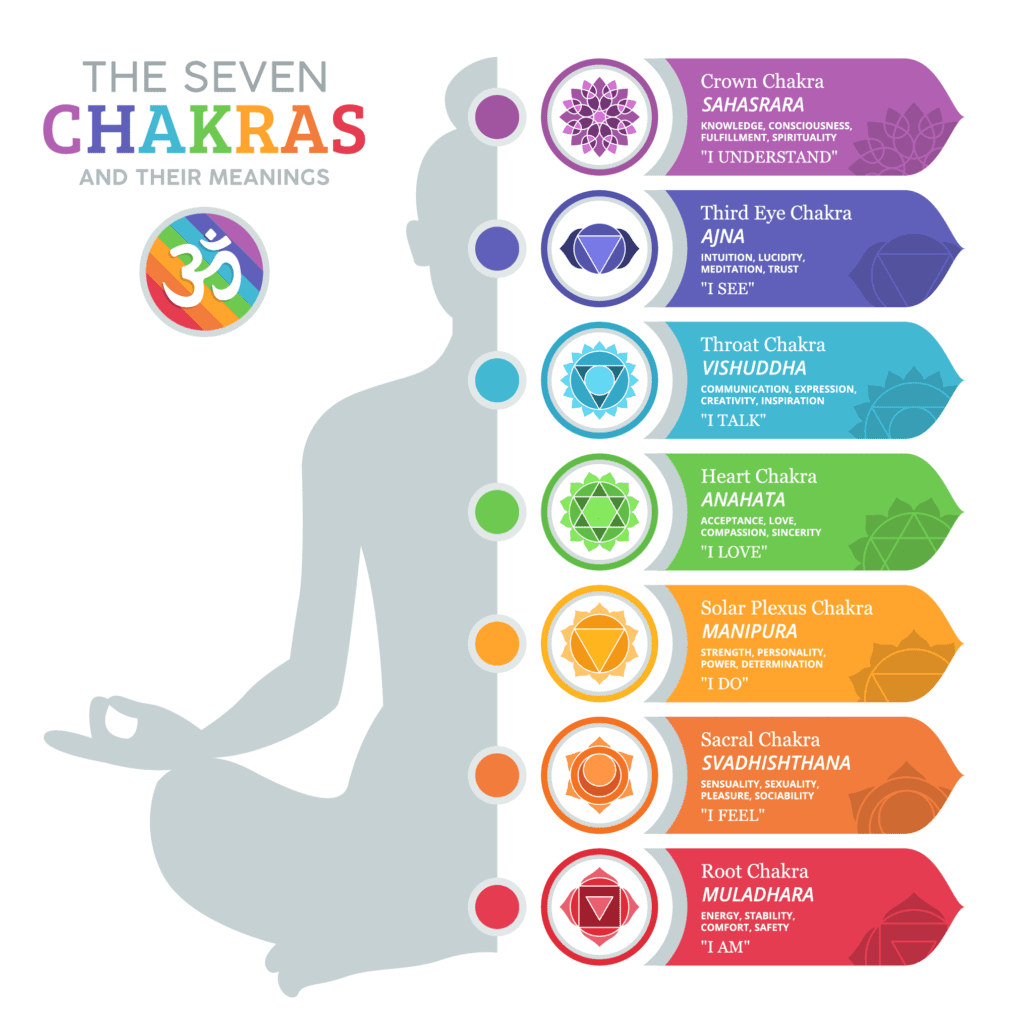
Chakra Meditation and Healing
Meditation techniques for chakra healing
Chakra meditation is a powerful practice that allows individuals to bring awareness to and harmonize their chakras. Various meditation techniques can be used to activate and attune the chakras. Specific guided meditations, visualization exercises, and focused breathing techniques can help individuals connect with each chakra, cleanse them of any blockages, and restore their natural flow and balance.
Benefits of chakra meditation
Chakra meditation offers numerous benefits for physical, emotional, and spiritual well-being. By regularly practicing chakra meditation, individuals can experience enhanced energy levels, improved focus and clarity, reduced stress and anxiety, increased self-awareness, and a deeper sense of inner peace and connection.
Use of crystals, sound, and essential oils in chakra healing
Crystals, sound, and essential oils are often utilized in chakra healing practices to amplify the effects and promote deeper energetic alignment. Each chakra corresponds to specific crystals, sounds, and essential oils that resonate with its energy. By incorporating these tools into chakra healing practices, individuals can enhance the healing and balancing experience, allowing for a more profound transformation.
Chakras and Yoga
Chakra-focused yoga poses and sequences
Yoga offers a powerful way to connect with and balance the chakras. Certain yoga poses are specifically designed to activate and stimulate the energy centers. For example, grounding poses like Mountain Pose (Tadasana) and Tree Pose (Vrikshasana) can help activate the root chakra, while hip-opening poses such as Bound Angle Pose (Baddha Konasana) and Goddess Pose (Utkata Konasana) can bring awareness to the sacral chakra.
Incorporating pranayama and mudras for chakra balance
In addition to yoga poses, pranayama (breathing exercises) and mudras (hand gestures) are utilized to channel and direct the energy flow within the chakras. Specific breathing techniques, such as Alternate Nostril Breathing (Nadi Shodhana), can balance and harmonize the chakras. Likewise, certain mudras, like Gyan Mudra (thumb and index finger touching), can enhance the activation and balance of the third eye chakra.
Yoga philosophy related to chakras
Yoga philosophy acknowledges the existence and significance of chakras. According to the yogic tradition, the chakras are not only energy centers but also represent different aspects of consciousness. The journey of spiritual evolution, as described in yoga philosophy, involves the awakening and purification of the chakras, leading to self-realization and union with the divine.
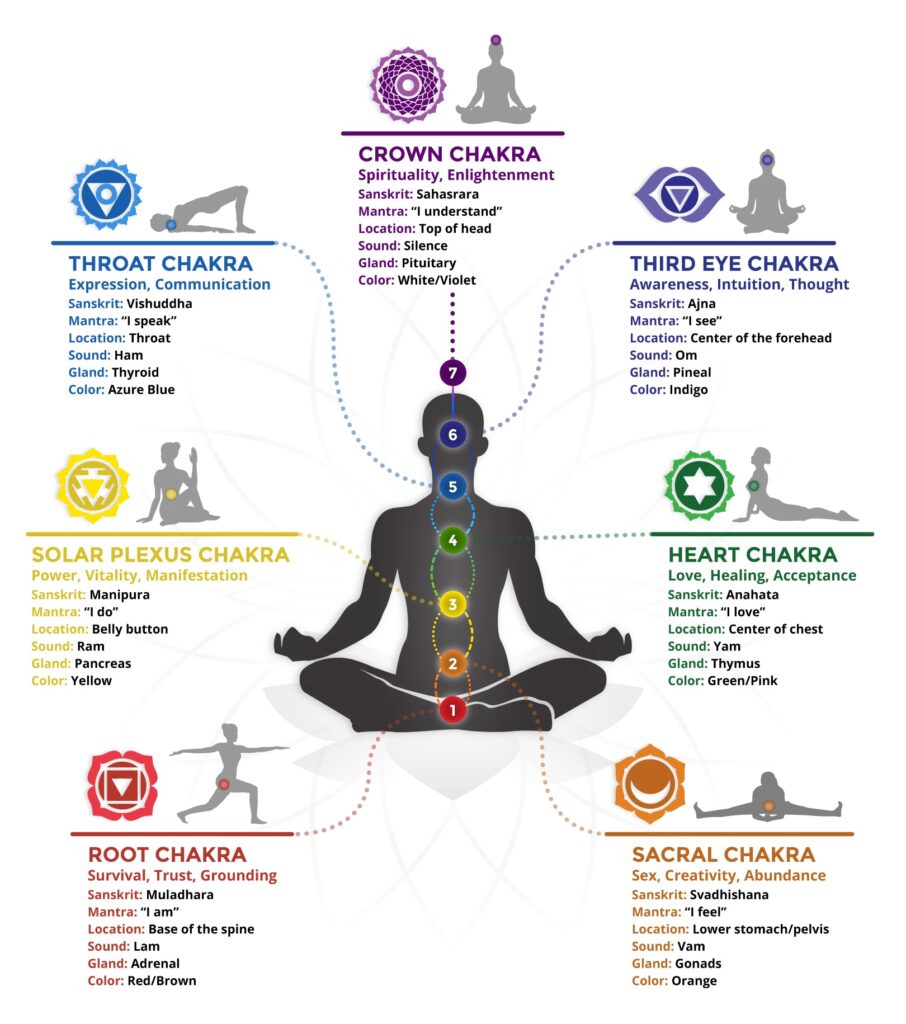
Chakras in Eastern and Western Traditions
Differences and similarities in the understanding of chakras in Eastern and Western spirituality
While Eastern and Western traditions have different approaches to understanding chakras, there are also notable similarities. Eastern traditions, such as Hinduism and Buddhism, view chakras as integral components of the subtle body and emphasize their role in spiritual practices. In Western spirituality, chakra concepts have been adapted and incorporated into various forms of energy healing, mindfulness practices, and alternative therapies.
Integration of chakras in modern holistic practices
In modern holistic practices, the concept of chakras has gained significant popularity and acceptance. With an increasing focus on overall well-being and self-care, chakras are often integrated into modalities like Reiki, acupuncture, Ayurveda, and various energy healing practices. The understanding of chakras provides a holistic framework through which individuals can explore and address the interconnectedness of their physical, emotional, and spiritual selves.
Chakra Awakening and Spiritual Growth
Awakening and activating dormant chakras
Awakening dormant chakras involves a deliberate and conscious process of expanding awareness and revitalizing blocked or inactive energy centers. Through dedicated practices such as meditation, energy healing, and self-reflection, individuals can gradually activate and align their dormant chakras, expanding their spiritual capacity and experiencing higher levels of consciousness.
Spiritual growth through chakra work
Chakra work is an integral part of spiritual growth. By exploring and understanding the chakras, individuals gain insight into their own energetic patterns, emotional blockages, and spiritual potential. Working with the chakras promotes self-awareness, inner healing, and personal transformation, thereby accelerating spiritual growth and the journey towards self-realization.
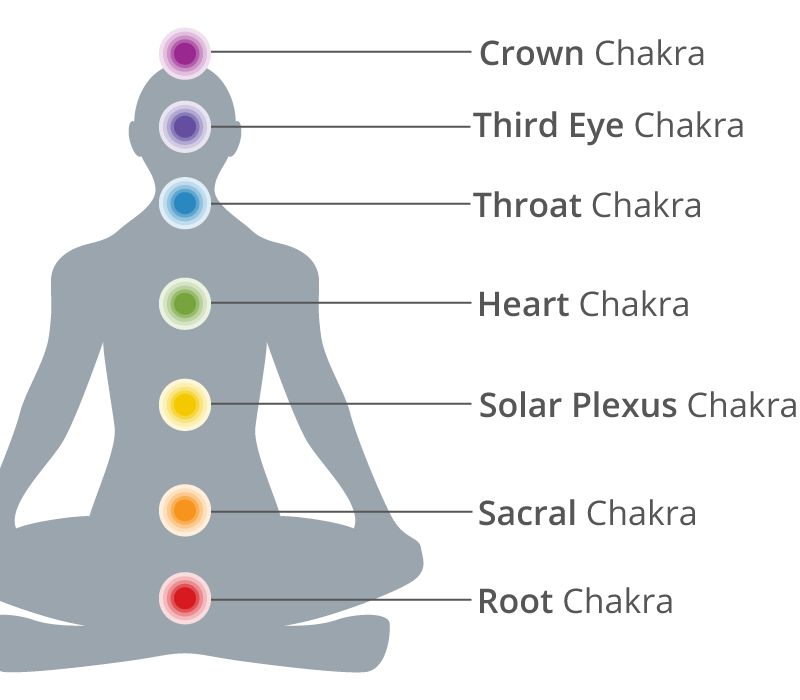
Chakra Healing Modalities
Reiki and chakra healing
Reiki, a Japanese energy healing modality, often incorporates chakra healing techniques. Reiki practitioners channel healing energy into the recipient, focusing on clearing and balancing the chakras. By directing Reiki energy to specific chakras, practitioners aim to remove blockages, restore harmony, and facilitate overall well-being.
Acupuncture and chakra harmony
Acupuncture, a traditional Chinese medicine practice, views the body as an interconnected system of energy pathways or meridians. By targeting specific acupuncture points, practitioners aim to restore the balance of energy flow throughout the body, including the chakras. Acupuncture can help release stagnant energy and promote the harmonization of the chakras.
Ayurveda and balancing the doshas through chakras
Ayurveda, an ancient holistic system of medicine from India, recognizes the connection between chakras and the three doshas (Vata, Pitta, and Kapha), which are the primary energies that govern the body. Balancing the doshas involves harmonizing the chakras associated with each dosha, enhancing overall well-being and promoting optimal health.
Living in Alignment with Chakras
Incorporating chakra awareness in daily life
Living in alignment with the chakras involves consciously bringing awareness to their energy flow and integrating their qualities into daily life. This can be achieved through simple practices such as mindfulness, self-reflection, and intention setting. For example, focusing on the qualities of the heart chakra, such as love and compassion, can inspire kind and loving interactions with others.
Chakra-inspired lifestyle choices
Embracing a chakra-inspired lifestyle entails incorporating practices and choices that support the well-being of each chakra. This may involve engaging in activities aligned with specific chakras, such as dance or physical exercise for the sacral chakra or spending time in nature for the root chakra. Adopting healthy habits, nurturing relationships, and cultivating a balanced lifestyle can further enhance chakra alignment and create a sense of harmony and fulfillment.
By exploring and working with the chakras, individuals can embark on a journey of self-discovery, personal growth, and spiritual transformation. The understanding and activation of these powerful energy centers can unlock inner potential, promote holistic well-being, and ultimately lead to a more authentic and meaningful life.
